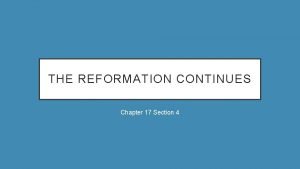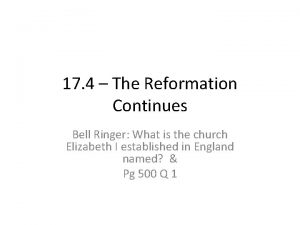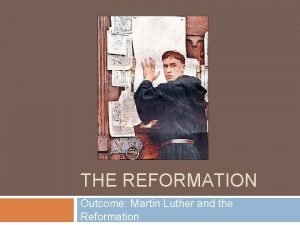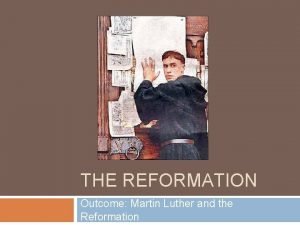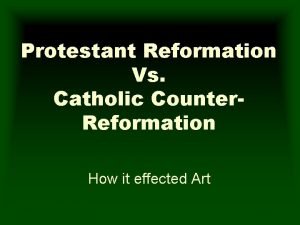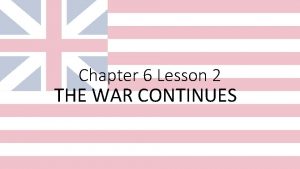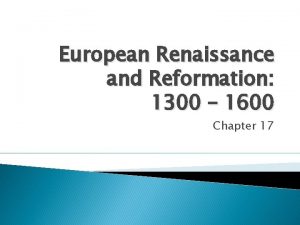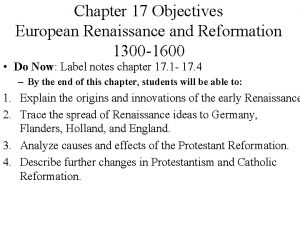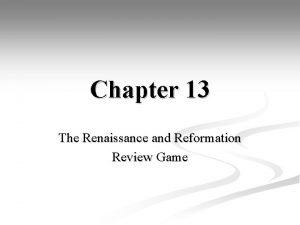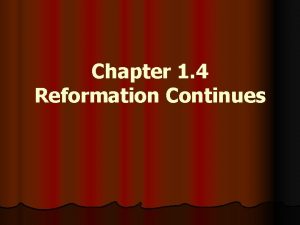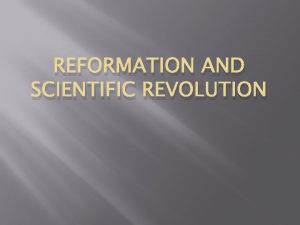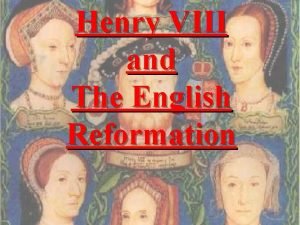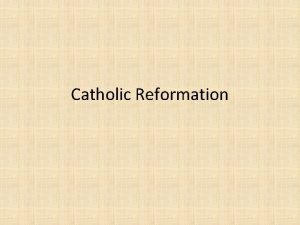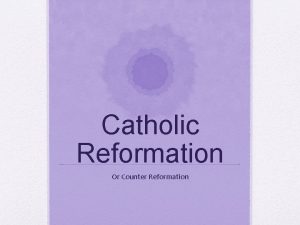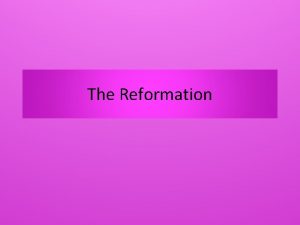Chapter 22 Reformation continues The English and the









- Slides: 9

Chapter 22 Reformation continues: The English and the Catholics

Questions to be addressed in this chapter 1. What was the English Reformation? 2. Who were the Puritans? 3. What were some of the primary and enduring offshoots of the Puritan movement? 4. What was the Catholic Counter-Reformation?

The English Reformation and Anglicanism • Henry VIII was a devout Catholic who opposed the Protestant movement, but he broke from Rome and became head of a national church in England. • Thomas Cranmer (1489 -1556) worked to “Protestantize” the Church as much as Henry would allow. • When Mary I became queen, she took the country back to Catholicism. • Queen Elizabeth found a middle way between Protestantism and Catholicism. The “Thirty-Nine Articles” were written as a doctrinal statement. Richard Hooker (1554 -1600) was instrumental in the development of this Anglicanism.

The Puritans • Puritans in England wanted more reform in doctrine, ecclesiology, and personal piety than the Anglicans made. • They hoped to model their belief and practice after Calvin’s society in Geneva. • Religious tolerance was created for all Protestants throughout England through the leadership of Oliver Cromwell (15991658).

Three forms of Church government in the sixteenth century • Episcopal: o Catholics, Anglicans, Orthodox • Presbyterian o Presbyterian and Reformed • Congregational o Puritans, Baptists, Anabaptists

Puritan offshoots: Baptists • Anglican minister John Smyth (c. 1570 -1612) is often recognized as the founder of the General Baptist movement in the Netherlands. They aligned closely with Arminian theology. • Particular Baptists in England stayed closer to Calvinist teaching. • Both groups of Baptists had emigrated to America and developed significant followings.

Puritan offshoots: Quakers • Founded by George Fox, who had a religious experience in 1647 that convinced him that God could speak to any person directly. • Outward religious signs were abolished, and Quakers sought to live simple lives. • They preached equality for women, race, and class. • William Penn (1655 -1718) was given a large tract of land in America, and many Quakers, Mennonites, Amish, and other similar groups flocked there.

The Catholic counter-Reformation • Once they saw the break with Protestants was final, a council of the Catholic Church was called in Trent, Italy. • The Council of Trent (1545 -1563) rejected the sola statements of Protestants and reaffirmed the Catholic theological and organizational positions. • In 1542 Pope Paul established the Inquisition in Rome to defend the Catholic faith and eradicate false teachings. • Ignatius of Loyola (1491 -1556) established the Society of Jesus, which served the pope as missionaries.

Summary of main points 1. The Church of England initially separated from Roman Catholicism over purely political motives, but matters of religious dissent were also key factors in its eventual move toward a middle way between Protestant and Catholic faith and practice: Anglicanism. 2. The Puritans began as a group of Calvinists in the Church of England in the sixteenth century who believed that the Anglican reforms did not go far enough in purifying the Church in faith and practice. 3. The Baptists and the Quakers were two offshoots of the Puritans which have endured as their own traditions. 4. The Catholic counter-Reformation was a series of theological and practical reforms which occurred in the Roman Catholic Church in the sixteenth century—some in response to Protestant Reformation challenges, others unrelated to Protestant ideas and critique.
 Chapter 17 section 4 the reformation continues
Chapter 17 section 4 the reformation continues Chapter 17 section 4 the reformation continues
Chapter 17 section 4 the reformation continues Chapter 17 section 4 the reformation continues answer key
Chapter 17 section 4 the reformation continues answer key The reformation outcome martin luther and the reformation
The reformation outcome martin luther and the reformation The reformation outcome martin luther and the reformation
The reformation outcome martin luther and the reformation Protestant reformation vs catholic reformation
Protestant reformation vs catholic reformation Chapter 6 lesson 2 the war continues
Chapter 6 lesson 2 the war continues European renaissance and reformation chapter 17
European renaissance and reformation chapter 17 European renaissance and reformation chapter 17
European renaissance and reformation chapter 17 Chapter 13 the renaissance and reformation
Chapter 13 the renaissance and reformation
